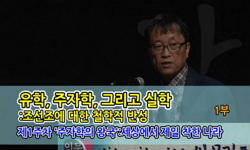이 논문은 ‘심학’으로서의 성호 철학의 이론적 지형과 지향을 검토하려는 것이다. 성호는 다양한 층위에서 心을 논의한다. 여기에는 사단칠정론이나 미발론과 같은 전통적인 주제 뿐 아...
http://chineseinput.net/에서 pinyin(병음)방식으로 중국어를 변환할 수 있습니다.
변환된 중국어를 복사하여 사용하시면 됩니다.
- 中文 을 입력하시려면 zhongwen을 입력하시고 space를누르시면됩니다.
- 北京 을 입력하시려면 beijing을 입력하시고 space를 누르시면 됩니다.

특집 1 : 심학(心學)과 실학(實學)의 재검토 ; 신체성, 일상성, 실천성, 공공성 : 성호 이익의 심학(心學) = Phisicality, Dailiness, Practicability, Publicness: The Mind-and-Heart Theory of Seongho Yi Ik
한글로보기https://www.riss.kr/link?id=A100272532
- 저자
- 발행기관
- 학술지명
- 권호사항
-
발행연도
2014
-
작성언어
Korean
-
주제어
성호 이익 ; 심학 ; 실학 ; 뇌낭설 ; 삼혼설 ; 미발론 ; 사칠론 ; 공사 ; 공희노 ; 대기소기설 ; 서학 ; 삼심설 ; Seongho Yi Ik ; heart-kidney theory ; 心腎說 ; brain-pocket theory ; 腦囊說 ; the theory of weifa ; 未發 ; not yet stirring ; Four-Seven Debate ; Western Learning ; 西學 ; the Mind-and-Heart Theory ; 心學
-
등재정보
KCI등재
-
자료형태
학술저널
-
수록면
77-123(47쪽)
- 제공처
-
0
상세조회 -
0
다운로드
부가정보
국문 초록 (Abstract)
이 논문은 ‘심학’으로서의 성호 철학의 이론적 지형과 지향을 검토하려는 것이다. 성호는 다양한 층위에서 心을 논의한다. 여기에는 사단칠정론이나 미발론과 같은 전통적인 주제 뿐 아니라 심신(心腎)설, 뇌낭(腦囊)설 등 신체와 연결된 이론 층위가 포함되어 있다. 성호는 신장(腎臟) 역시 심의 물리적 근거로 보려는 이만부의 입장에 반대해왔으나 서학의 삼혼설과 뇌낭설을 접한 뒤 심장 이외의 다른 인체 기관을 통해서도 심의 활동을 설명할 수 있음을 인정하게 된다. 성호는 지각과 판단, 도덕적 실천의 주체인 심을 초월적 차원에서 설명하기보다 인체의 기관과 작동을 통해 설명하고자 한다. 이러한 경향은 미발설에도 나타난다. 성호는 전통적으로 형이상학적 영역으로 여겨졌던 미발을 일상적인 감각 지각과 그에 따른 앎까지 포함하는 것으로 확장한다. 성호에게 이발의 경계는 의식 여부, 리에 대한 형이상학적 지각 여부가 아니라 和의 여부다. 일상적 인식과 판단은 여전히 미발에 속하며 오직 윤리적 판단과 결단이 있을 때 이를 이발로 여기는 것이다. 결국 성호는 미발, 이발을 심과 성의 관계가 아니라 지각과 도덕적 실천의 관계로 파악하고자 한다. 더 나아가 그는 사칠론에서 이 도덕적 실천의 마음을 公의 차원으로 규정함으로써 마음의 기원보다 그 실질적 작동의 문제에 주목한다. 이런 관점에서 본다면 성호의 심학은 마음의 형이상학적 근원성이나 우주에 대한 포괄성, 가치 인식의 즉각성을 표현하는 말이 아니라 지각, 사려, 판단, 도덕적 실천 등 다양한 분기와 계기로 분화되는 인식과 도덕적 실천의 과정을 의미할 것이다. 성호는 형이상학적이고 이념적으로 선언된 性에서 물리적 토대와 구체적 작동의 방식을 포괄하는 구체적인 心으로 논점을 전환한 것이다.
다국어 초록 (Multilingual Abstract)
This article is aimed at examination of the theoretical topography and orientation of philosophy of Seongho Yi Ik. Seongho deals with the traditional Confucian subject of xin[心] from various perspectives. It includes not only traditional themes such...
This article is aimed at examination of the theoretical topography and orientation of philosophy of Seongho Yi Ik. Seongho deals with the traditional Confucian subject of xin[心] from various perspectives. It includes not only traditional themes such as Four-Seven Debate and the theory of weifa[未發; not yet stirring], but also physical level like heart-kidney theory[心腎說], brain-pocket theory[腦囊說], and so on. He had been against the heart-kidney theory of Lee, Man-bu(李萬敷) which regarded kidney as another physical basis of xin just as heart, but he came to acknowledge that the activities of xin could be explained through another organs of the body besides heart. Seongho tries to explain xin, which is an agent of cognition, judgment and moral practice, through organs and operation of human body rather than its transcendental dimension. The trend is also found in his theory of weifa. He extends the concept of weifa which was traditionally regarded as being in the metaphysical domain, to including sensory perception of everyday life and its data. For him, the boundary of yifa[已發; already expressed one`s feelings] is whether or not xin is in the state of he[和; harmony], not whether xin perceives something or recognizes Li[理] metaphysically. He regards sensory perception of everyday life and its data as the part of weifa, and only regards something with moral judgment and decision as the part of yifa. Consequently, he tries to consider the relationship between weifa and yifa as the one between cognition and moral practice, not Xin and Xing[性]. Furthermore, he focuses on the matter of actual operation of the moral practical xin, rather than its origin, by defining the Xin in terms of the public dimension[公]. In this respect, his theory of Mind-and-Heart does not mean metaphysical origin of Xin or its embracement of universe, but the process of cognition and moral practice of Xin, which would be divided into perception, consideration, judgment, moral practice and so on. He changes his point from metaphysical and ideologically declared xing to concrete xin including its physical basis and concrete process of its operation.
동일학술지(권/호) 다른 논문
-
특집 1 : 심학(心學)과 실학(實學)의 재검토 ; 퇴계 심학에서 성호학으로 흐르는 두 갈래 길 -정구의 『심경부주』해석과 이만부의 사단칠정론-
- 한국실학학회
- 이상호 ( Sang Ho Lee )
- 2014
- KCI등재
-
특집 1 : 심학(心學)과 실학(實學)의 재검토 ; 율곡학파의 심학과 실학 -경계적 사유와 실천의 갈림길에서-
- 한국실학학회
- 김경호 ( Kyung Ho Kim )
- 2014
- KCI등재
-
- 한국실학학회
- 한정길 ( Jeong Gil Han )
- 2014
- KCI등재
-
특집 2 : 18세기를 읽는 몇 가지 키워드, 통,흥,맛 ; 18세기 국왕의 소통 방식
- 한국실학학회
- 김문식 ( Moon Sik Kim )
- 2014
- KCI등재




 KCI
KCI KISS
KISS






